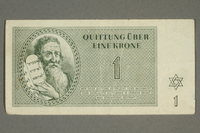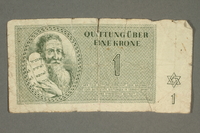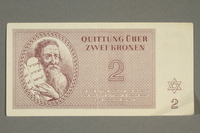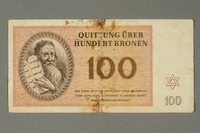Overview
- Brief Narrative
- Yellow factory-printed Star of David badge worn by Lucie Fried (later Steinhagen) while living in Vienna, Austria. After the German annexation of Austria in 1938, anti-Jewish legislation was quickly introduced and Jewish-owned businesses and property were confiscated. Lucie had to leave her public school, her mother lost the family retail store, and her brother was imprisoned in Dachau concentration camp for three weeks before immigrating to the United States. A quota on Polish immigrants prevented Lucie's Polish born mother, Fanny, from obtaining a visa for the United States. Lucie stayed with Fanny in Vienna and began volunteering at a Jewish-run community garden. On September 1, 1941, all Jews in the Reich six years of age or older were required to wear a badge which consisted of a yellow, black-outlined Star of David with the word “Jew” printed inside the star in German or in the local language. The badge was used to stigmatize and control the Jewish population. Lucie wore this badge everywhere she went, until she, her mother, and her grandmother were deported to the Theresienstadt ghetto-camp in German-occupied Czechoslovakia in August 1942. Her grandmother died after five months, but Lucie and Fanny lived in Theresienstadt for three years until the Soviet Army liberated the camp on May 9, 1945. They eventually re-located to the Deggendorf displaced persons camp before immigrating to New York in 1946.
- Date
-
use:
approximately 1941-approximately 1942
- Geography
-
use:
Vienna (Austria)
- Credit Line
- United States Holocaust Memorial Museum Collection, Gift of Lucie Steinhagen
- Markings
- Front, center, printed, black ink: JUDE [Jew]
- Contributor
-
Donor:
Lucie Steinhagen
- Biography
-
Lucie Steinhagen (nee Fried) was born in 1921 in Vienna, Austria. The daughter of Moritz Fried (c. 1880-1930) and Fanny Weiss (c. 1883-1961, born in Poland), she was the youngest of four children: She had a sister, Hedy (later Ringel, 1911-2007), a brother, Arthur (1918-1992), and another brother who died in Vienna at the age of four. Due to the age gap, Lucie was not very close with Hedy, but was close with her brother and cousins who were around the same age. While Fanny came from a religious home, Moritz did not; as a result they were moderate in their religious practices, going to synagogue on holidays. Moritz owned a retail store in Vienna. They lived a comfortable middle-class life until Moritz died in 1930 when Lucie was about 9 years old. Fanny continued to run the store after his death, but life became increasingly difficult for the family. Prior to the war, Lucie had an active social life, and went to school with Jewish and non-Jewish children alike. Due to Fanny’s strong religious background, she instilled in Lucie a sense of pride in being Jewish.
On March 13, 1938, Austria was annexed into Germany, in what became known as the "Anschluss." The Germans quickly introduced anti-Jewish legislation and confiscated Jewish-owned businesses and property. Prior to that time, Lucie had no awareness or understanding of the events happening outside of Vienna, but shortly before turning seventeen, she had to leave her public school and never completed her education. Shortly thereafter, someone walked into the Frieds’ store, asked Fanny for the keys and told her to walk out. The family lost their means of support, requiring Fanny to move in with her mother and Lucie to move in with her aunt and three cousins nearby.
After Kristallnacht in November 1938, 6,000 Jewish men in Vienna were arrested (including Lucie’s brother, uncles, and cousin) and sent to the Dachau concentration camp. Most of the men in the Dachau concentration camp were released if they could provide proof of plans to emigrate from Germany; Lucie’s brother, Arthur, was imprisoned there for about three weeks before his release in late December. Shortly thereafter, Lucie and her siblings received affidavits to immigrate from their aunts who were living in the United States. Hedy left with her family in October 1938 and Arthur went shortly thereafter. The United States had a quota on Polish immigrants which prevented Fanny, who was born in Poland, from obtaining a visa. Lucie stayed with her mother for a few years before she too planned to emigrate. Despite having booked a ticket to America, the outbreak of war in Austria prevented her from getting to her departure point In Italy.
In lieu of attending school, Lucie began volunteering with Vienna’s Jewish community center, planting vegetables to benefit the old age and children’s’ homes in an empty section of a Jewish cemetery. Lucie, Fanny, and her grandmother (Jeanette Weiss) were forcibly deported in August 1942 and sent to the Theresienstadt ghetto-camp in German-occupied Czechoslovakia. Although Theresienstadt was part of the Nazi propaganda scheme, disease and starvation were rampant and the camp regularly deported Jews to other ghettos, concentration camps, and extermination camps in other Nazi-occupied areas of Europe. Although Theresienstadt was overseen by a German authority who implemented orders, it was largely run by a Jewish Administration, which organized municipal services, labor detachments, and cultural life.
Lucie was asked to help register people, which led her to a job in the Theresienstadt record office. The record office was primarily responsible for registering new people, tracking relatives, attempting to make records of families, and delivering packages with little to no addressee information. She credited her job in the records office as the reason she and her mother were never assigned to a transport out of Theresienstadt, and helped to get her grandmother off of the transport she was assigned to. Lucie’s mother did not work while in the camp, and her grandmother died about five months after arriving. While in the ghetto-labor camp, Lucie met Margaret Simon (later Hantman), who became a lifelong friend. Lucie and Fanny lived in Theresienstadt for three years before the Soviet Army liberated the camp on May 9, 1945. Days earlier, trains came with refugees from various concentration camps, many of whom died on the way or shortly after getting off the trains. It was only then that Lucie and the others at Theresienstadt learned what had happened at the concentration camps.
In August 1945, Lucie and Fanny traveled to the Deggendorf displaced persons. In the eight months they resided at Deggendorf, Lucie was involved in activities, such as a musical review in which she appeared in a Statue of Liberty costume. It was at Deggendorf that Lucie met Gerhard Steinhagen (b. 1924), a refugee from Berlin who had also been imprisoned at Theresienstadt in June 1942 (he would later be transferred to Zossen-Wulkow bei Trebnitz, a forced-labor camp near Berlin, the Auschwitz II-Birkenau death camp in Poland, and the Gleiwitz III concentration camp in Germany). Although they did not know each other personally at Theresienstadt, she knew of him as some of her friends lived in the same house. While in Deggendorf, they kept company, but did not think that they would stay together after they immigrated to New York, as Lucie expected to go to Ohio to stay with her sister. Lucie and Fanny were on the first transport, arriving in New York on May 20, 1946. They stayed there with extended family for a short time before traveling to Ohio. Lucie eventually returned to New York, and married Gerhard on November 25, 1947. They settled in the Bronx and had two children; Randy (b. 1951) went on to become a surgeon and Renee (b. 1955) became a lawyer. Fanny Fried died in 1961. Gerhard Steinhagen died in 2003.
Physical Details
- Language
- German
- Classification
-
Identifying Artifacts
- Category
-
Badges
- Object Type
-
Star of David badges (lcsh)
- Genre/Form
- Magen David.
- Physical Description
- A dark yellow cloth badge in the shape of a 6-pointed Star of David stitched to a striped backing fabric. The star outline is formed from 2 overlapping, dyed triangles and has German text in a font resembling Hebrew in the center. A small loop of black thread extends from the top point while a tuft of frayed black thread extends from the bottom point. The backing fabric is light gray with thin pinstripes in red, navy/black, and light blue/gray. In the center of the back is an approximately 1” vertical slit that has been closed with overcast stitching in gray thread. The edges of both sides are folded over, hiding the seams. A thick crease extends horizontally across the middle of the badge, creaking a pucker in the backing fabric. There are areas of discoloration and a few small stains on the surface.
- Dimensions
- overall: Height: 3.375 inches (8.573 cm) | Width: 2.750 inches (6.985 cm) | Depth: 0.125 inches (0.318 cm)
- Materials
- overall : cloth, thread, ink
Rights & Restrictions
- Conditions on Access
- No restrictions on access
- Conditions on Use
- No restrictions on use
Keywords & Subjects
- Topical Term
- Jews--Persecutions--Austria--Vienna. Antisemitism--Austria--Vienna. Identification (Religion) Star of David badges.
- Geographic Name
- Vienna (Austria)
Administrative Notes
- Legal Status
- Permanent Collection
- Provenance
- The badge was donated to the United States Holocaust Memorial Museum in 2018 by Lucie Steinhagen.
- Record last modified:
- 2022-07-28 20:13:53
- This page:
- https://collections.ushmm.org/search/catalog/irn610417
Also in Lucie Steinhagen collection
The collection consists of photographs, song lyrics, a Star of David, scrip, and a document relating to the experiences of Lucie Steinhagen and her friend Rita Rosenberger in Deggendorf displaced persons camp, Theresienstadt ghetto-labor camp, Vienna, and Freiberg during the Holocaust.
Date: approximately 1941-approximately 1946

Theresienstadt ghetto-labor camp scrip, 1 krone note, belonging to an Austrian Jewish woman
Object
Scrip, valued at 1 krone, distributed in Theresienstadt (Terezin) ghetto-labor camp, obtained by inmate Lucie Fried (Steinhagen). Currency was confiscated from inmates and replaced with scrip, which could only be used in the camp. The scrip was part of an elaborate illusion to make the camp seem normal and appear as though workers were being paid for their labor, but the money had no real monetary value. Lucie was deported to Theresienstadt from Vienna, Austria in August 1942, accompanied by her mother, Fanny Fried, and her grandmother, Jeanette Weiss. Lucie had a job in the Jewish-run record office at Theresienstadt, which she credited as the reason she and her mother were never assigned to a transport out, and helped to get her grandmother off of the transport she was assigned to. Jeannette died after about five months, but Lucie and Fanny lived in Theresienstadt for three years until the Soviet Army liberated the camp on May 9, 1945. They eventually re-located to the Deggendorf displaced persons camp, where Lucie met Gerhard Steinhagen, a refugee from Berlin who had also been imprisoned at Theresienstadt in June 1942. The two would eventually marry in New York in 1947.

Theresienstadt ghetto-labor camp scrip, 1 krone note, belonging to an Austrian Jewish woman
Object
Scrip, valued at 1 krone, distributed in Theresienstadt (Terezin) ghetto-labor camp, obtained by inmate Lucie Fried (Steinhagen). Currency was confiscated from inmates and replaced with scrip, which could only be used in the camp. The scrip was part of an elaborate illusion to make the camp seem normal and appear as though workers were being paid for their labor, but the money had no real monetary value. Lucie was deported to Theresienstadt from Vienna, Austria in August 1942, accompanied by her mother, Fanny Fried, and her grandmother, Jeanette Weiss. Lucie had a job in the Jewish-run record office at Theresienstadt, which she credited as the reason she and her mother were never assigned to a transport out, and helped to get her grandmother off of the transport she was assigned to. Jeannette died after about five months, but Lucie and Fanny lived in Theresienstadt for three years until the Soviet Army liberated the camp on May 9, 1945. They eventually re-located to the Deggendorf displaced persons camp, where Lucie met Gerhard Steinhagen, a refugee from Berlin who had also been imprisoned at Theresienstadt in June 1942. The two would eventually marry in New York in 1947.

Theresienstadt ghetto-labor camp scrip, 2 kronen note, belonging to an Austrian Jewish woman
Object
Scrip, valued at 2 kronen, distributed in Theresienstadt (Terezin) ghetto-labor camp, obtained by inmate Lucie Fried (Steinhagen). Currency was confiscated from inmates and replaced with scrip, which could only be used in the camp. The scrip was part of an elaborate illusion to make the camp seem normal and appear as though workers were being paid for their labor, but the money had no real monetary value. Lucie was deported to Theresienstadt from Vienna, Austria in August 1942, accompanied by her mother, Fanny Fried, and her grandmother, Jeanette Weiss. Lucie had a job in the Jewish-run record office at Theresienstadt, which she credited as the reason she and her mother were never assigned to a transport out, and helped to get her grandmother off of the transport she was assigned to. Jeannette died after about five months, but Lucie and Fanny lived in Theresienstadt for three years until the Soviet Army liberated the camp on May 9, 1945. They eventually re-located to the Deggendorf displaced persons camp, where Lucie met Gerhard Steinhagen, a refugee from Berlin who had also been imprisoned at Theresienstadt in June 1942. The two would eventually marry in New York in 1947.

Theresienstadt ghetto-labor camp scrip, 100 kronen note, belonging to an Austrian Jewish woman
Object
Scrip, valued at 100 kronen, distributed in Theresienstadt (Terezin) ghetto-labor camp, obtained by inmate Lucie Fried (Steinhagen). Currency was confiscated from inmates and replaced with scrip, which could only be used in the camp. The scrip was part of an elaborate illusion to make the camp seem normal and appear as though workers were being paid for their labor, but the money had no real monetary value. Lucie was deported to Theresienstadt from Vienna, Austria in August 1942, accompanied by her mother, Fanny Fried, and her grandmother, Jeanette Weiss. Lucie had a job in the Jewish-run record office at Theresienstadt, which she credited as the reason she and her mother were never assigned to a transport out, and helped to get her grandmother off of the transport she was assigned to. Jeannette died after about five months, but Lucie and Fanny lived in Theresienstadt for three years until the Soviet Army liberated the camp on May 9, 1945. They eventually re-located to the Deggendorf displaced persons camp, where Lucie met Gerhard Steinhagen, a refugee from Berlin who had also been imprisoned at Theresienstadt in June 1942. The two would eventually marry in New York in 1947.
Lucie Steinhagen collection
Document
Contains photographs of theatrical productions at the Deggendorf DP camp; photos of friends who perished; lyrics of songs sung at Theresienstadt; and document granting police permission to travel on a street car in Freiberg, issued to Rita Rosenberger, dated 1942.



